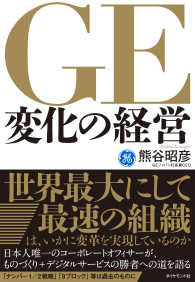- ホーム
- > 洋書
- > 英文書
- > Science / Mathematics
Full Description
When Western missionaries introduced modern chemistry to China in the 1860s, they called this discipline hua-hsueh, literally, 'the study of change'. In this first full-length work on science in modern China, James Reardon-Anderson describes the introduction and development of chemistry in China in the late nineteenth and early twentieth centuries, and examines the impact of the science on language reform, education, industry, research, culture, society, and politics. Throughout the book, Professor Reardon-Anderson sets the advance of chemistry in the broader context of the development of science in China and the social and political changes of this era. His thesis is that science fared well at times when a balance was struck between political authority and free social development. Based on Chinese and English sources, the narrative moves from detailed descriptions of particular chemical processes and innovations to more general discussions of intellectual and social history, and provides a fascinating account of an important episode in the intellectual history of modern China.
Contents
Abbreviations; Preface; Introduction; Part I. Science and Self-Strengthening, 1840-1895: 1. The advocates: chemical translators, John Fryer and Hsü Shou; 2. Changing Chinese: chemical translations of the Kiangnan Arsenal; 3. The limits of change: science, state and society in the nineteenth century; Part II. The Interregnum, 1895-1927: 4. First-generation scientists: makers of China's new culture; 5. Learning about science; 6. The beginning of chemical research; 7. Chinese entrepreneurs and the rise of the chemical industry; Part III. The Nanking Decade, 1927-1937: 8. Science and the state during the Nanking Decade; 9. Scientific education: the balance achieved; 10. Scientific research: the balance threatened; 11. The chemical industry and the limits of growth; Part IV. The War, 1937-1945: 12. Science in nationalist China: the wartime experience; 13. Science in communist China I: innovations in industry; 14. Science in communist China II: scientists versus the state; 15. Conclusion; Appendix; Glossary; Bibliography; Index.
-

- 電子書籍
- 想像もできなかった令嬢の人生【タテヨミ…
-

- 電子書籍
- 仮面のメイドガイ【分冊版】(66)
-

- 電子書籍
- 異世界に転生したら全裸にされた WEB…
-

- 電子書籍
- オジサマ社長の愛しい人(単話版) ハッ…
-

- 電子書籍
- GE変化の経営



